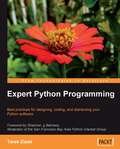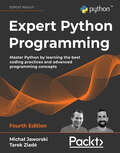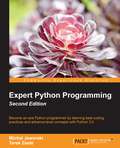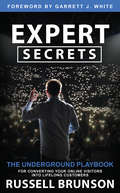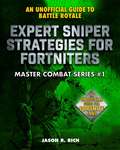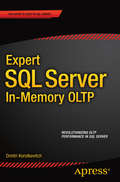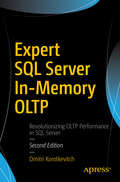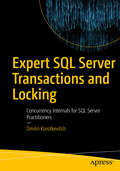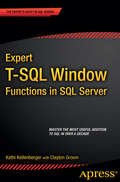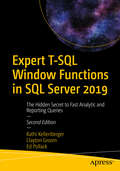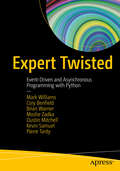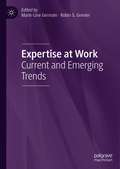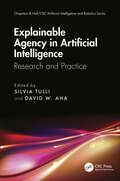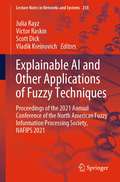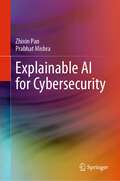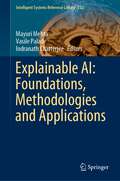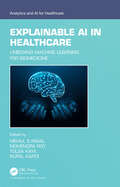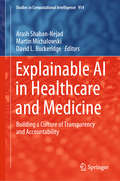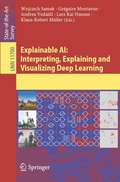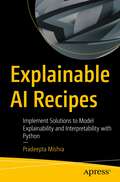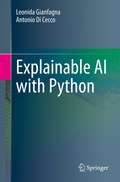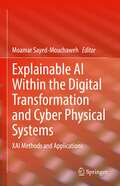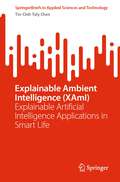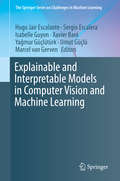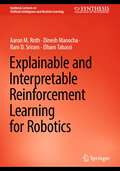- Table View
- List View
Expert Python Programming
by Tarek ZiadeThis book is an authoritative exploration of Python best practices and applications of agile methodologies to Python, illustrated with practical, real-world examples. This book is for Python developers who are already building applications, but want to build better ones by applying best practices and new development techniques to their projects. The reader is expected to have a sound background in Python programming.
Expert Python Programming: Master Python by learning the best coding practices and advanced programming concepts, 4th Edition
by Tarek Ziade Michal JaworskiAttain a deep understanding of building, maintaining, packaging, and shipping robust Python applicationsKey FeaturesDiscover the new features of Python, such as dictionary merge, the zoneinfo module, and structural pattern matchingCreate manageable code to run in various environments with different sets of dependenciesImplement effective Python data structures and algorithms to write, test, and optimize codeBook DescriptionPython is used in a wide range of domains owing to its simple yet powerful nature. Although writing Python code is easy, making it readable, reusable, and easy to maintain can be challenging. Complete with best practices, useful tools, and standards implemented by professional Python developers, this fourth edition will help you in not only overcoming such challenges but also learning Python's latest features and advanced concepts. The book begins with a warm-up, where you will catch-up with the latest Python improvements, syntax elements, and interesting tools to boost your development efficiency. Further, the initial few chapters should allow experienced programmers coming from different languages to safely land in the Python ecosystem. As you progress, you will explore common software design patterns and various programming methodologies, such as event-driven programming, concurrency, and metaprogramming. You will also go through complex code examples and try to solve meaningful problems by bridging Python with C and C++, writing extensions that benefit from the strengths of multiple languages. Finally, you will understand the complete lifetime of any application after it goes live. By the end of the book, you should be proficient in writing efficient and maintainable Python code.What you will learnExplore modern ways of setting up repeatable and consistent Python development environmentsEffectively package Python code for community and production useLearn about modern syntax elements of Python programming, such as f-strings, dataclasses, enums, and lambda functionsDemystify metaprogramming in Python with metaclassesWrite concurrent code in PythonMonitor and optimize the performance of Python applicationExtend and integrate Python with code written in different languagesWho this book is forThe Python programming book is intended for expert programmers who want to learn Python's advanced-level concepts and latest features.Anyone who has basic Python skills should be able to follow the content of the book, although it might require some additional effort from less experienced programmers. It should also be a good introduction to Python 3.9 for those who are still a bit behind and continue to use other older versions.
Expert Python Programming - Second Edition
by Tarek Ziade Michal JaworskiBecome an ace Python programmer by learning best coding practices and advance-level concepts with Python 3.5 About This Book * Based on the latest stable version of Python (version 3.5) * Creating well manageable code that will run in various environments with different sets of dependencies * Packed with advanced concepts and best practices to write efficient Python code Who This Book Is For The book would appeal to web developers and Python programmers who want to start using version 3.5 and write code efficiently. Basic knowledge of Python programming is expected. What You Will Learn * Conventions and best practices that are widely adopted in the python community * Package python code effectively for community and production use * Easy and lightweight ways to automate code deployment on remote systems * Improve your code's quality, reliability, and performance * Write concurrent code in python * Extend python with code written in different languages In Detail Python is a dynamic programming language, used in a wide range of domains by programmers who find it simple, yet powerful. Even if you find writing Python code easy, writing code that is efficient and easy to maintain and reuse is a challenge. The focus of the book is to familiarize you with common conventions, best practices, useful tools and standards used by python professionals on a daily basis when working with code. You will begin with knowing new features in Python 3.5 and quick tricks for improving productivity. Next, you will learn advanced and useful python syntax elements brought to this new version. Using advanced object-oriented concepts and mechanisms available in python, you will learn different approaches to implement metaprogramming. You will learn to choose good names, write packages, and create standalone executables easily. You will also be using some powerful tools such as buildout and vitualenv to release and deploy the code on remote servers for production use. Moving on, you will learn to effectively create Python extensions with C, C++, cython, and pyrex. The important factors while writing code such as code management tools, writing clear documentation, and test-driven development are also covered. You will now dive deeper to make your code efficient with general rules of optimization, strategies for finding bottlenecks, and selected tools for application optimization. By the end of the book, you will be an expert in writing efficient and maintainable code. Style and approach An easy-to-follow guide that covers industry followed best practices in Python programming
Expert Secrets: The Underground Playbook for Converting Your Online Visitors into Lifelong Customers
by Russell BrunsonMaster the art of what to say in your funnels to convert your online visitors into lifelong customers in this updated edition from the $100M entrepreneur and co-founder of the software company ClickFunnels.Your business is a calling. You've been called to serve a group of people with the products, services, and offers that you've created. The impact that the right message can have on someone at the right time in their life is immeasurable. Your message could help to save marriages, repair families, change someone's health, grow a company, or more. . . . But only if you know how to get it into the hands of the people whose lives you have been called to change.By positioning yourself as an expert and telling your story in a way that gets people to move, you will be able to guide people through your value ladder, offer solutions to their problems, and give them the results they are looking for. This is how you change the lives of your customers, and this is how you grow your company.In this updated edition of Expert Secrets, Russell Brunson, CEO and co-founder of the multimillion-dollar software company ClickFunnels, gives you the step-by-step strategies you need to turn your expertise into a carefully crafted sales message that will attract your dream customers.Don't hide inside your business. Implement these story selling techniques now so you can find your voice and gain the confidence to become a leader, build a movement of people whose lives you can change, and make this calling a career.
Expert Sniper Strategies for Fortniters: An Unofficial Guide to Battle Royale (Master Combat)
by Jason RichHit your target every time with this Fortnite expert sniper guide. This all‑new, unofficial, illustrated guide series will turn you into a master Fortnite: Battle Royale gamer by uncovering all the best strategies and secrets of this wildly popular game. Whether you play Fortnite Battle Royale on a PC, Mac, Xbox One, PlayStation 4, or your mobile device, you’ll find everything you need to stay at the top of your game. Each book is packed with useful insider tips on topics like, staying alive longer, exploring, collecting a powerful arsenal, building, and snagging more victories during each match. When it comes to achieving #1 Victory Royale, the Fortnite Battle Royale: Master Combat Series provides the ultimate competitive edge. Thanks to this comprehensive how‑to Fortnite shooting guide, you’ll gain the crucial battle skills you need to eliminate your enemies like a pro. Sniper rifles and projectile weapons are only as good as the player using them. This comprehensive resource will sharpen your skills and show you how and when to use the incredible range of guns, weapons, tools, and ammunition available during each match. There’s nothing more important in Fortnite than staying alive longer and battling your way to #1 Victory Royale. This straightforward guide has everything you need to prepare for long‑range, mid‑range, and close‑range combat situations so that you can emerge a winner.
Expert SQL Server In-Memory OLTP
by Dmitri KorotkevitchExpert SQL Server In-Memory OLTP is a deep dive into one of the most significant features of SQL Server 2014 - support for In-Memory Online Transaction Processing. The book describes the architecture and internals of the In-Memory OLTP Engine and explains how to develop, deploy, and maintain systems using it. With it you can dramatically increase transactional throughput to handle thousands of transactions per second supporting millions of customers. Dmitri Korotkevitch is the five-star author of Pro SQL Server Internals, and now brings his same combination of clear thinking and deep expertise to the question of how to recognize the opportunities and benefit from Microsoft's In-Memory OLTP feature set in SQL Server 2014. Learn the architecture and the internals in order to recognize when in-memory OLTP can make a difference. Learn useful scenarios for thoughtfully incorporating In-Memory support into existing applications. Recognize opportunities for In-Memory OLTP in new development. Don't be without Dmitri Korotkevitch and the deep expertise he imparts in Expert SQL Server In-Memory OLTP as you move forward in using SQL Server's new and important In-Memory OLTP feature set. Covers In-Memory OLTP internals and architecture, including data storage, indexing, multi-version concurrency control, transaction logging, and recovery Illustrates In-Memory OLTP programmability and the process of native compilation Guides in using In-Memory OLTP in new development and existing systems. What you'll learn Grasp the internal mechanisms underlying in-memory tables and their implementation Plan successful implementations, including the required memory size and I/O configuration Properly index in-memory tables, including with hash indexes and range indexes Accelerate T-SQL processing through the creation of natively-compiled stored procedures Control disk I/O by managing logging, checkpoint, and recovery of in-memory data Monitor and report on the benefits and performance of your in-memory solutions Who this book is for Expert SQL Server In-Memory OLTP is for application developers and database administrators who create and manage online transaction processing (OLTP) systems. In particular, the book is aimed at those wanting to take advantage of SQL Server's new offering of in-memory OLTP to dramatically improve performance and throughput of their systems. Table of Contents Introduction 1. Why In-Memory OLTP? 2. In-Memory OLTP Objects 3. Memory-Optimized Tables 4. Hash Indexes 5. Nonclustered Indexes 6. In-Memory OLTP Prgrammability 7. In-Memory OLTP Concurrency Model 8. Data Storage, Logging, and Recovery 9. Garbage Collection 10. Deployment and Management 11. Utilizing In-Memory OLTP 12. Appendix A: Memory Pointer Management 13. Appendix B: Page Splitting and Merging in Nonclustered Indexes 14. Appendix C: Analyzing Checkpoint File Pair State 15. Appendix D: In-Memory OLTP Migration Tools
Expert SQL Server In-Memory OLTP
by Dmitri KorotkevitchExpert SQL Server In-Memory OLTP is a deep dive into one of the most significant features of SQL Server 2014 - support for In-Memory Online Transaction Processing. The book describes the architecture and internals of the In-Memory OLTP Engine and explains how to develop, deploy, and maintain systems using it. With it you can dramatically increase transactional throughput to handle thousands of transactions per second supporting millions of customers. Dmitri Korotkevitch is the five-star author of Pro SQL Server Internals, and now brings his same combination of clear thinking and deep expertise to the question of how to recognize the opportunities and benefit from Microsoft's In-Memory OLTP feature set in SQL Server 2014. Learn the architecture and the internals in order to recognize when In-Memory OLTP can make a difference. Learn useful scenarios for thoughtfully incorporating in-memory support into existing applications. Recognize opportunities for In-Memory OLTP in new development. Don't be without Dmitri Korotkevitch and the deep expertise he imparts in Expert SQL Server In-Memory OLTP as you move forward in using SQL Server's new and important In-Memory OLTP feature set. Covers In-Memory OLTP internals and architecture, including data storage, indexing, multi-version concurrency control, transaction logging, and recovery Illustrates In-Memory OLTP programmability and the process of native compilation Guides in using In-Memory OLTP in new development and existing systems.
Expert SQL Server Transactions and Locking: Concurrency Internals for SQL Server Practitioners
by Dmitri KorotkevitchMaster SQL Server’s Concurrency Model so you can implement high-throughput systems that deliver transactional consistency to your application customers. This book explains how to troubleshoot and address blocking problems and deadlocks, and write code and design database schemas to minimize concurrency issues in the systems you develop.SQL Server’s Concurrency Model is one of the least understood parts of the SQL Server Database Engine. Almost every SQL Server system experiences hard-to-explain concurrency and blocking issues, and it can be extremely confusing to solve those issues without a base of knowledge in the internals of the Engine. While confusing from the outside, the SQL Server Concurrency Model is based on several well-defined principles that are covered in this book.Understanding the internals surrounding SQL Server’s Concurrency Model helps you build high-throughput systems in multi-user environments. This book guides you through the Concurrency Model and elaborates how SQL Server supports transactional consistency in the databases. The book covers all versions of SQL Server, including Microsoft Azure SQL Database, and it includes coverage of new technologies such as In-Memory OLTP and Columnstore Indexes.What You'll LearnKnow how transaction isolation levels affect locking behavior and concurrencyTroubleshoot and address blocking issues and deadlocksProvide required data consistency while minimizing concurrency issuesDesign efficient transaction strategies that lead to scalable codeReduce concurrency problems through good schema designUnderstand concurrency models for In-Memory OLTP and Columnstore IndexesReduce blocking during index maintenance, batch data load, and similar tasksWho This Book Is ForSQL Server developers, database administrators, and application architects who are developing highly-concurrent applications. The book is for anyone interested in the technical aspects of creating and troubleshooting high-throughput systems that respond swiftly to user requests.
Expert T-SQL Window Functions in SQL Server
by Kathi Kellenberger Clayton GroomExpert T-SQL Window Functions in SQL Server takes you from any level of knowledge of windowing functions and turns you into an expert who can use these powerful functions to solve many T-SQL queries. Replace slow cursors and self-joins with queries that are easy to write and fantastically better performing, all through the magic of window functions. First introduced in SQL Server 2005, window functions came into full blossom with SQL Server 2012. They truly are one of the most notable developments in SQL in a decade, and every developer and DBA can benefit from their expressive power in solving day-to-day business problems. Begin using windowing functions like ROW_NUMBER and LAG, and you will discover more ways to use them every day. You will approach SQL Server queries in a different way, thinking about sets of data instead of individual rows. Your queries will run faster, they will be easier to write, and they will be easier to deconstruct and maintain and enhance in the future. Just knowing and using these functions is not enough. You also need to understand how to tune the queries. Expert T-SQL Window Functions in SQL Server explains clearly how to get the best performance. The book also covers the rare cases when older techniques are the best bet. Stop using cursors and self-joins to solve complicated queries. Become a T-SQL expert by mastering windowing functions. Teaches you how to use all the window functions introduced in 2005 and 2012. Provides real-world examples that you can experiment with in your own database. Explains how to get the best performance when using windowing functions. What you'll learn Create aggregations by defining sets of rows with the OVER clause. Calculate aggregates without losing the details. Rank and bucketize data for reporting purposes. Reduce and often eliminate self-joins. Reduce and often eliminate row-by-row cursor processing. Write simpler queries that perform with greater speed. Recognize situations when window functions make a difference. Who this book is for Expert T-SQL Window Functions in SQL Server is for the SQL Server database professionals who are ready to take on the biggest leap in query-writing expressiveness and performance to hit the SQL language in years. It's for developers and database administrators who may have heard about windowing functions, but who haven't had a chance to learn much about them. Expert T-SQL Window Functions in SQL Server is an excellent way for database professionals to get up to speed on these functions and put their benefits to work. Table of Contents 1. Looking through the Window 2. Discovering Ranking Functions 3. Aggregating with Window Functions 4. Tuning for Better Performance 5. Calculating Rolling and Running Aggregates 6. Adding Frames to the Window 7. Peaking at Other Rows 8. Understanding Statistical Functions 9. The Future of Window Functions
Expert T-SQL Window Functions in SQL Server 2019: The Hidden Secret to Fast Analytic and Reporting Queries
by Kathi Kellenberger Clayton Groom Ed PollackBecome an expert who can use window functions to solve T-SQL query problems. Replace slow cursors and self-joins with queries that are easy to write and perform better. This new edition provides expanded examples, including a chapter from the world of sports, and covers the latest performance enhancements through SQL Server 2019. Window functions are useful in analytics and business intelligence reporting. They came into full blossom with SQL Server 2012, yet they are not as well known and used as often as they ought to be. This group of functions is one of the most notable developments in SQL, and this book shows how every developer and DBA can benefit from their expressive power in solving day-to-day business problems. Once you begin using window functions, such as ROW_NUMBER and LAG, you will discover many ways to use them. You will approach SQL Server queries in a different way, thinking about sets of data instead of individual rows. Your queries will run faster, be easier to write, and easier to deconstruct, maintain, and enhance in the future.Just knowing and using these functions is not enough. You also need to understand how to tune the queries. Expert T-SQL Window Functions in SQL Server clearly explains how to get the best performance. The book also covers the rare cases when older techniques are the best bet.What You Will LearnSolve complex query problems without cumbersome self-joins that run slowly and are difficult to readCreate sliding windows in a result set for computing such as running totals and moving averagesReturn aggregate and detail data simultaneously from the same SELECT statementCompute lag and lead and other values that access data from multiple rows in a result setUnderstand the OVER clause syntax and how to control the windowAvoid framing errors that can lead to unexpected resultsWho This Book Is For Anyone who writes T-SQL queries, including database administrators, developers, business analysts, and data scientists. Before reading this book, you should understand how to join tables, write WHERE clauses, and build aggregate queries.
Expert Twisted: Event-driven And Asynchronous Programming With Python
by Pierre Tardy Kevin Samuel Dustin Mitchell Moshe Zadka Brian Warner Cory Benfield Mark WilliamsExplore Twisted, the Python-based event-driven networking engine, and review several of its most popular application projects. It is written by community leaders who have contributed to many of the projects covered, and share their hard-won insights and experience.Expert Twisted starts with an introduction to event-driven programming, explaining it in the context of what makes Twisted unique. It shows how Twisted's design emphasizes testability as a solution to common challenges of reliability, debugging, and start-to-finish causality that are inherent in event-driven programming. It also explains asynchronous programming, and the importance of functions, deferreds, and coroutines. It then uses two popular applications, treq and klein, to demonstrate calling and writing Web APIs with Twisted.The second part of the book dives into Twisted projects, in each case explaining how the project fits into the Twisted ecosystem and what it does, and offers several examples to bring readers up to speed, with pointers to additional resources for more depth. Examples include using Twisted with Docker, as a WSGI container, for file sharing, and more.What You'll LearnIntegrate Twisted and asyncio using adaptersAutomate software build, test, and release processes with BuildbotCreate clients and servers with AutobahnTransfer files with Magic WormholeDistribute cloud-based file storage with Tahoe LAFSUnderstand HTTP/2 with Python and TwistedSupport for asynchronous tasks using Django ChannelsWho This Book Is ForReaders should have some Python experience and understand the essentials of containers and protocols, but need not be familiar with Twisted or the associated projects covered in the book.
Expertise at Work: Current and Emerging Trends
by Marie-Line Germain Robin S. GrenierExpertise, which combines knowledge, years of experience in one domain, problem-solving skills, and behavioral traits, is a valuable resource for organizations. To understand the diverse picture of expertise in the workplace, this book offers scholars and scholar-practitioners a comprehensive assessment of the development of human expertise in organizations. Using contemporary perspectives across a broad range of domains, contributors offer readers various professional perspectives including veterans, education, sports, and information technology. The book also describes how researchers and practitioners can address practical problems related to the development, redevelopment, and sustainability of expertise. Finally, the book puts specific emphasis on the emerging trends in the study and practice of expertise in organizations, including the use of artificial intelligence.
Explainable Agency in Artificial Intelligence: Research and Practice (Chapman & Hall/CRC Artificial Intelligence and Robotics Series)
by Silvia Tulli David W. AhaThis book focuses on a subtopic of explainable AI (XAI) called explainable agency (EA), which involves producing records of decisions made during an agent’s reasoning, summarizing its behavior in human-accessible terms, and providing answers to questions about specific choices and the reasons for them. We distinguish explainable agency from interpretable machine learning (IML), another branch of XAI that focuses on providing insight (typically, for an ML expert) concerning a learned model and its decisions. In contrast, explainable agency typically involves a broader set of AI-enabled techniques, systems, and stakeholders (e.g., end users), where the explanations provided by EA agents are best evaluated in the context of human subject studies. The chapters of this book explore the concept of endowing intelligent agents with explainable agency, which is crucial for agents to be trusted by humans in critical domains such as finance, self-driving vehicles, and military operations. This book presents the work of researchers from a variety of perspectives and describes challenges, recent research results, lessons learned from applications, and recommendations for future research directions in EA. The historical perspectives of explainable agency and the importance of interactivity in explainable systems are also discussed. Ultimately, this book aims to contribute to the successful partnership between humans and AI systems. Features: • Contributes to the topic of explainable artificial intelligence (XAI) • Focuses on the XAI subtopic of explainable agency • Includes an introductory chapter, a survey, and five other original contributions
Explainable AI and Other Applications of Fuzzy Techniques: Proceedings of the 2021 Annual Conference of the North American Fuzzy Information Processing Society, NAFIPS 2021 (Lecture Notes in Networks and Systems #258)
by Julia Rayz Victor Raskin Scott Dick Vladik KreinovichThis book focuses on an overview of the AI techniques, their foundations, their applications, and remaining challenges and open problems. Many artificial intelligence (AI) techniques do not explain their recommendations. Providing natural-language explanations for numerical AI recommendations is one of the main challenges of modern AI. To provide such explanations, a natural idea is to use techniques specifically designed to relate numerical recommendations and natural-language descriptions, namely fuzzy techniques. This book is of interest to practitioners who want to use fuzzy techniques to make AI applications explainable, to researchers who may want to extend the ideas from these papers to new application areas, and to graduate students who are interested in the state-of-the-art of fuzzy techniques and of explainable AI—in short, to anyone who is interested in problems involving fuzziness and AI in general.
Explainable AI for Cybersecurity
by Zhixin Pan Prabhat MishraThis book provides a comprehensive overview of security vulnerabilities and state-of-the-art countermeasures using explainable artificial intelligence (AI). Specifically, it describes how explainable AI can be effectively used for detection and mitigation of hardware vulnerabilities (e.g., hardware Trojans) as well as software attacks (e.g., malware and ransomware). It provides insights into the security threats towards machine learning models and presents effective countermeasures. It also explores hardware acceleration of explainable AI algorithms. The reader will be able to comprehend a complete picture of cybersecurity challenges and how to detect them using explainable AI. This book serves as a single source of reference for students, researchers, engineers, and practitioners for designing secure and trustworthy systems.
Explainable AI: Foundations, Methodologies and Applications (Intelligent Systems Reference Library #232)
by Mayuri Mehta Vasile Palade Indranath ChatterjeeThis book presents an overview and several applications of explainable artificial intelligence (XAI). It covers different aspects related to explainable artificial intelligence, such as the need to make the AI models interpretable, how black box machine/deep learning models can be understood using various XAI methods, different evaluation metrics for XAI, human-centered explainable AI, and applications of explainable AI in health care, security surveillance, transportation, among other areas.The book is suitable for students and academics aiming to build up their background on explainable AI and can guide them in making machine/deep learning models more transparent. The book can be used as a reference book for teaching a graduate course on artificial intelligence, applied machine learning, or neural networks. Researchers working in the area of AI can use this book to discover the recent developments in XAI. Besides its use in academia, this book could be used by practitioners in AI industries, healthcare industries, medicine, autonomous vehicles, and security surveillance, who would like to develop AI techniques and applications with explanations.
Explainable AI in Healthcare: Unboxing Machine Learning for Biomedicine (Analytics and AI for Healthcare)
by Mehul S Raval Mohendra Roy Tolga Kaya Rupal KapdiThis book combines technology and the medical domain. It covers advances in computer vision (CV) and machine learning (ML) that facilitate automation in diagnostics and therapeutic and preventive health care. The special focus on eXplainable Artificial Intelligence (XAI) uncovers the black box of ML and bridges the semantic gap between the technologists and the medical fraternity. Explainable AI in Healthcare: Unboxing Machine Learning for Biomedicine intends to be a premier reference for practitioners, researchers, and students at basic, intermediary levels and expert levels in computer science, electronics and communications, information technology, instrumentation and control, and electrical engineering. This book will benefit readers in the following ways: Explores state of art in computer vision and deep learning in tandem to develop autonomous or semi-autonomous algorithms for diagnosis in health care Investigates bridges between computer scientists and physicians being built with XAI Focuses on how data analysis provides the rationale to deal with the challenges of healthcare and making decision-making more transparent Initiates discussions on human-AI relationships in health care Unites learning for privacy preservation in health care
Explainable AI in Healthcare and Medicine: Building a Culture of Transparency and Accountability (Studies in Computational Intelligence #914)
by Arash Shaban-Nejad Martin Michalowski David L. BuckeridgeThis book highlights the latest advances in the application of artificial intelligence and data science in health care and medicine. Featuring selected papers from the 2020 Health Intelligence Workshop, held as part of the Association for the Advancement of Artificial Intelligence (AAAI) Annual Conference, it offers an overview of the issues, challenges, and opportunities in the field, along with the latest research findings. Discussing a wide range of practical applications, it makes the emerging topics of digital health and explainable AI in health care and medicine accessible to a broad readership. The availability of explainable and interpretable models is a first step toward building a culture of transparency and accountability in health care. As such, this book provides information for scientists, researchers, students, industry professionals, public health agencies, and NGOs interested in the theory and practice of computational models of public and personalized health intelligence.
Explainable AI: Interpreting, Explaining and Visualizing Deep Learning (Lecture Notes in Computer Science #11700)
by Klaus-Robert Müller Grégoire Montavon Wojciech Samek Andrea Vedaldi Lars Kai HansenThe development of “intelligent” systems that can take decisions and perform autonomously might lead to faster and more consistent decisions. A limiting factor for a broader adoption of AI technology is the inherent risks that come with giving up human control and oversight to “intelligent” machines. For sensitive tasks involving critical infrastructures and affecting human well-being or health, it is crucial to limit the possibility of improper, non-robust and unsafe decisions and actions. Before deploying an AI system, we see a strong need to validate its behavior, and thus establish guarantees that it will continue to perform as expected when deployed in a real-world environment. In pursuit of that objective, ways for humans to verify the agreement between the AI decision structure and their own ground-truth knowledge have been explored. Explainable AI (XAI) has developed as a subfield of AI, focused on exposing complex AI models to humans in a systematic and interpretable manner. The 22 chapters included in this book provide a timely snapshot of algorithms, theory, and applications of interpretable and explainable AI and AI techniques that have been proposed recently reflecting the current discourse in this field and providing directions of future development. The book is organized in six parts: towards AI transparency; methods for interpreting AI systems; explaining the decisions of AI systems; evaluating interpretability and explanations; applications of explainable AI; and software for explainable AI.
Explainable AI Recipes: Implement Solutions to Model Explainability and Interpretability with Python
by Pradeepta MishraUnderstand how to use Explainable AI (XAI) libraries and build trust in AI and machine learning models. This book utilizes a problem-solution approach to explaining machine learning models and their algorithms. The book starts with model interpretation for supervised learning linear models, which includes feature importance, partial dependency analysis, and influential data point analysis for both classification and regression models. Next, it explains supervised learning using non-linear models and state-of-the-art frameworks such as SHAP values/scores and LIME for local interpretation. Explainability for time series models is covered using LIME and SHAP, as are natural language processing-related tasks such as text classification, and sentiment analysis with ELI5, and ALIBI. The book concludes with complex model classification and regression-like neural networks and deep learning models using the CAPTUM framework that shows feature attribution, neuron attribution, and activation attribution. After reading this book, you will understand AI and machine learning models and be able to put that knowledge into practice to bring more accuracy and transparency to your analyses.What You Will LearnCreate code snippets and explain machine learning models using PythonLeverage deep learning models using the latest code with agile implementationsBuild, train, and explain neural network models designed to scaleUnderstand the different variants of neural network models Who This Book Is ForAI engineers, data scientists, and software developers interested in XAI
Explainable AI with Python
by Leonida Gianfagna Antonio Di CeccoThis book provides a full presentation of the current concepts and available techniques to make “machine learning” systems more explainable. The approaches presented can be applied to almost all the current “machine learning” models: linear and logistic regression, deep learning neural networks, natural language processing and image recognition, among the others.Progress in Machine Learning is increasing the use of artificial agents to perform critical tasks previously handled by humans (healthcare, legal and finance, among others). While the principles that guide the design of these agents are understood, most of the current deep-learning models are "opaque" to human understanding. Explainable AI with Python fills the current gap in literature on this emerging topic by taking both a theoretical and a practical perspective, making the reader quickly capable of working with tools and code for Explainable AI.Beginning with examples of what Explainable AI (XAI) is and why it is needed in the field, the book details different approaches to XAI depending on specific context and need. Hands-on work on interpretable models with specific examples leveraging Python are then presented, showing how intrinsic interpretable models can be interpreted and how to produce “human understandable” explanations. Model-agnostic methods for XAI are shown to produce explanations without relying on ML models internals that are “opaque.” Using examples from Computer Vision, the authors then look at explainable models for Deep Learning and prospective methods for the future. Taking a practical perspective, the authors demonstrate how to effectively use ML and XAI in science. The final chapter explains Adversarial Machine Learning and how to do XAI with adversarial examples.
Explainable AI Within the Digital Transformation and Cyber Physical Systems: XAI Methods and Applications
by Moamar Sayed-MouchawehThis book presents Explainable Artificial Intelligence (XAI), which aims at producing explainable models that enable human users to understand and appropriately trust the obtained results. The authors discuss the challenges involved in making machine learning-based AI explainable. Firstly, that the explanations must be adapted to different stakeholders (end-users, policy makers, industries, utilities etc.) with different levels of technical knowledge (managers, engineers, technicians, etc.) in different application domains. Secondly, that it is important to develop an evaluation framework and standards in order to measure the effectiveness of the provided explanations at the human and the technical levels. This book gathers research contributions aiming at the development and/or the use of XAI techniques in order to address the aforementioned challenges in different applications such as healthcare, finance, cybersecurity, and document summarization. It allows highlighting the benefits and requirements of using explainable models in different application domains in order to provide guidance to readers to select the most adapted models to their specified problem and conditions.Includes recent developments of the use of Explainable Artificial Intelligence (XAI) in order to address the challenges of digital transition and cyber-physical systems;Provides a textual scientific description of the use of XAI in order to address the challenges of digital transition and cyber-physical systems;Presents examples and case studies in order to increase transparency and understanding of the methodological concepts.
Explainable Ambient Intelligence: Explainable Artificial Intelligence Applications in Smart Life (SpringerBriefs in Applied Sciences and Technology)
by Tin-Chih Toly ChenThis book systematically reviews the progress of Explainable Ambient Intelligence (XAmI) and introduces its methods, tools, and applications. Ambient intelligence (AmI) is a vision in which an environment supports the people inhabiting it in an unobtrusive, interconnected, adaptable, dynamic, embedded, and intelligent way. So far, artificial intelligence (AI) technologies have been widely applied in AmI. However, some advanced AI methods are not easy to understand or communicate, especially for users with insufficient background knowledge of AI, which undoubtedly limits the practicability of these methods. To address this issue, explainable AI (XAI) has been considered a viable strategy. Although XAI technologies and tools applied in other fields can also be applied to explain AI technology applications in AmI, users should be the main body in the application of AmI, which is slightly different from the application of AI technologies in other fields. This book containsreal case studies of the application of XAml and is a valuable resource for students and researchers.
Explainable and Interpretable Models in Computer Vision and Machine Learning (The Springer Series on Challenges in Machine Learning)
by Hugo Jair Escalante Sergio Escalera Isabelle Guyon Xavier Baró Yağmur Güçlütürk Umut Güçlü Marcel Van GervenThis book compiles leading research on the development of explainable and interpretable machine learning methods in the context of computer vision and machine learning. Research progress in computer vision and pattern recognition has led to a variety of modeling techniques with almost human-like performance. Although these models have obtained astounding results, they are limited in their explainability and interpretability: what is the rationale behind the decision made? what in the model structure explains its functioning? Hence, while good performance is a critical required characteristic for learning machines, explainability and interpretability capabilities are needed to take learning machines to the next step to include them in decision support systems involving human supervision. This book, written by leading international researchers, addresses key topics of explainability and interpretability, including the following: · Evaluation and Generalization in Interpretable Machine Learning · Explanation Methods in Deep Learning · Learning Functional Causal Models with Generative Neural Networks · Learning Interpreatable Rules for Multi-Label Classification · Structuring Neural Networks for More Explainable Predictions · Generating Post Hoc Rationales of Deep Visual Classification Decisions · Ensembling Visual Explanations · Explainable Deep Driving by Visualizing Causal Attention · Interdisciplinary Perspective on Algorithmic Job Candidate Search · Multimodal Personality Trait Analysis for Explainable Modeling of Job Interview Decisions · Inherent Explainability Pattern Theory-based Video Event Interpretations
Explainable and Interpretable Reinforcement Learning for Robotics (Synthesis Lectures on Artificial Intelligence and Machine Learning)
by Aaron M. Roth Dinesh Manocha Ram D. Sriram Elham TabassiThis book surveys the state of the art in explainable and interpretable reinforcement learning (RL) as relevant for robotics. While RL in general has grown in popularity and been applied to increasingly complex problems, several challenges have impeded the real-world adoption of RL algorithms for robotics and related areas. These include difficulties in preventing safety constraints from being violated and the issues faced by systems operators who desire explainable policies and actions. Robotics applications present a unique set of considerations and result in a number of opportunities related to their physical, real-world sensory input and interactions. The authors consider classification techniques used in past surveys and papers and attempt to unify terminology across the field. The book provides an in-depth exploration of 12 attributes that can be used to classify explainable/interpretable techniques. These include whether the RL method is model-agnostic or model-specific, self-explainable or post-hoc, as well as additional analysis of the attributes of scope, when-produced, format, knowledge limits, explanation accuracy, audience, predictability, legibility, readability, and reactivity. The book is organized around a discussion of these methods broken down into 42 categories and subcategories, where each category can be classified according to some of the attributes. The authors close by identifying gaps in the current research and highlighting areas for future investigation.
